How can accessible workspace be designed?
Meeting the needs of occupiers and operators
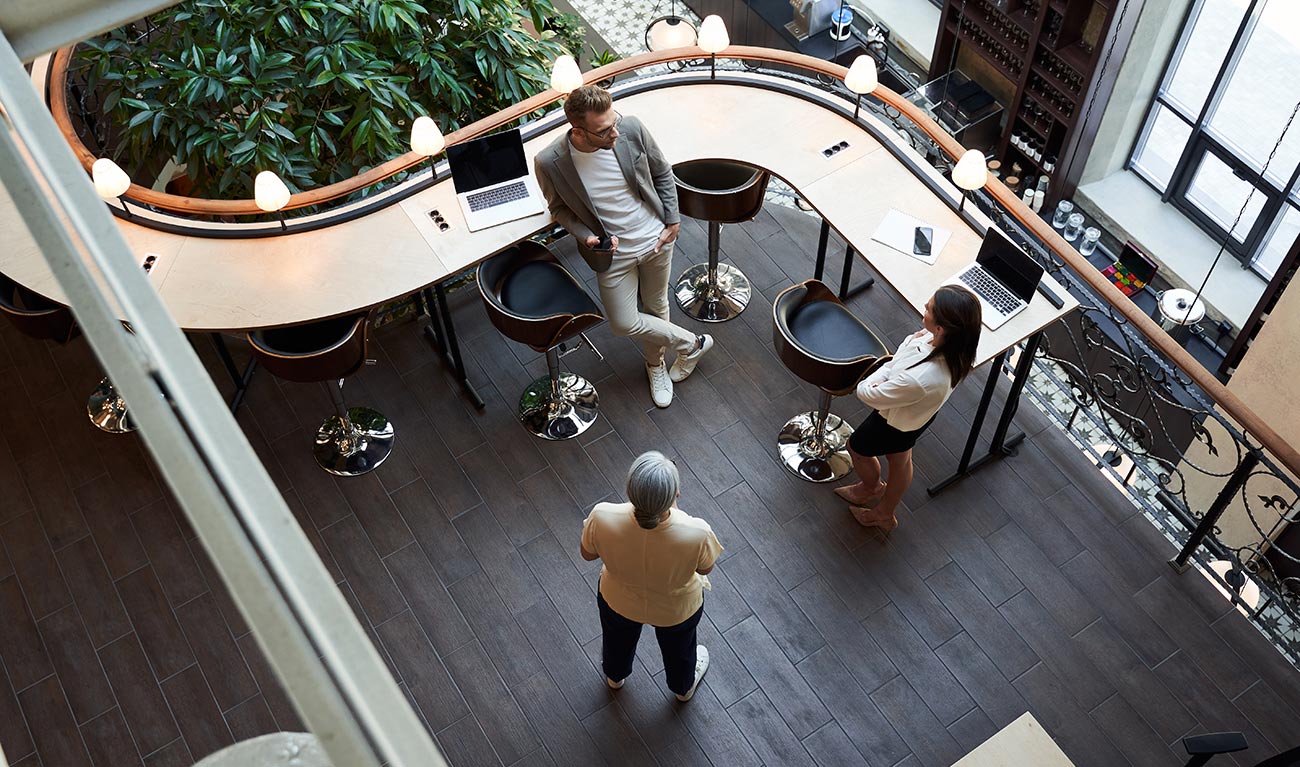
This blog post focuses on design considerations for ‘accessible’ workspace. It is the last in a five-part series, produced in a collaboration between Avison Young, 5th Studio, and Meanwhile Space. Previous posts consider what accessible workspace is, why it’s needed, where it should be located and where it is currently found.
Changing ecology of employment and work
Historically towns and cities have provided a wide range of accommodation, facilitating different types of work and production. This commonly included workshops on high streets, where cobblers made shoes, tailors sewed suits, cloth was woven, and goods were displayed in street facing windows for sale.
Traditionally similar business types were often clustered together, supporting each other and sharing local resources. These places for work evolved alongside infrastructure to support the needs of a community including religious buildings, inns, public houses and schools.
The UK’s rapid industrialisation brought a shift to large factories and warehouses, more remote from the home, and connected to waterways, roads and later railways. This separation was reinforced by zonal planning by use class.
The economic and cultural ecology of work and employment is constantly evolving. Today the availability of suitable space in many towns and cities to establish and grow small businesses is diminishing, for example, London has lost a quarter of its industrial floorspace to other uses in the last 20 years. ‘Accessible workspace’ is not a new typology, but there is an ongoing need to build strategic plans that provide spaces to support business retention and growth.
Lessons can be learnt from the heritage of our places for work, and successful accessible workspaces that currently exist, so we can better plan for the future. These lessons are about supporting the social and economic ecologies of our buildings, neighbourhoods, and towns and cities.
Traditionally similar business types were often clustered together, supporting each other and sharing local resources. These places for work evolved alongside infrastructure to support the needs of a community including religious buildings, inns, public houses and schools.
The UK’s rapid industrialisation brought a shift to large factories and warehouses, more remote from the home, and connected to waterways, roads and later railways. This separation was reinforced by zonal planning by use class.
The economic and cultural ecology of work and employment is constantly evolving. Today the availability of suitable space in many towns and cities to establish and grow small businesses is diminishing, for example, London has lost a quarter of its industrial floorspace to other uses in the last 20 years. ‘Accessible workspace’ is not a new typology, but there is an ongoing need to build strategic plans that provide spaces to support business retention and growth.
Lessons can be learnt from the heritage of our places for work, and successful accessible workspaces that currently exist, so we can better plan for the future. These lessons are about supporting the social and economic ecologies of our buildings, neighbourhoods, and towns and cities.
Principals of good workspace design
Successful places for work are accessible - with good public transport, walking and cycling connections - close to accessible housing, so the commute from home to work is short and attractive. They also have access to amenities such as grocery shops, nurseries, schools, cafes, amenities and places to socialise, so day-to-day routines can be carried out with ease alongside work. This adjacency facilitates exchange and integration in neighbourhoods. Recent discussions about the benefits of creating 15-minute cities, with this diversity of uses, is helping to champion the creation of sustainable neighbourhoods. For businesses that distribute goods, being close to road transport infrastructure is also important.
Some businesses, especially smaller start-up businesses, can benefit from being part of a collection of similar organisations – sharing resources, management and building networks. It provides opportunities for knowledge exchange, serendipitous encounters important for innovation and co-dependency between businesses. A collective identity can also make businesses easier to find by potential customers, clients, or visitors. This identity can be at the scale of an estate, urban block, or building.
Some businesses, especially smaller start-up businesses, can benefit from being part of a collection of similar organisations – sharing resources, management and building networks. It provides opportunities for knowledge exchange, serendipitous encounters important for innovation and co-dependency between businesses. A collective identity can also make businesses easier to find by potential customers, clients, or visitors. This identity can be at the scale of an estate, urban block, or building.
Good workspace design embeds the principals of collective collaboration, with shared facilities, amenities, and access within a building. This can include individual work units, leased by separate businesses, shared workspace, meetings rooms and equipment, and spaces to socialise, eat and drink that provide an opportunity for collaboration and exchange with those in the building and the wider local community.
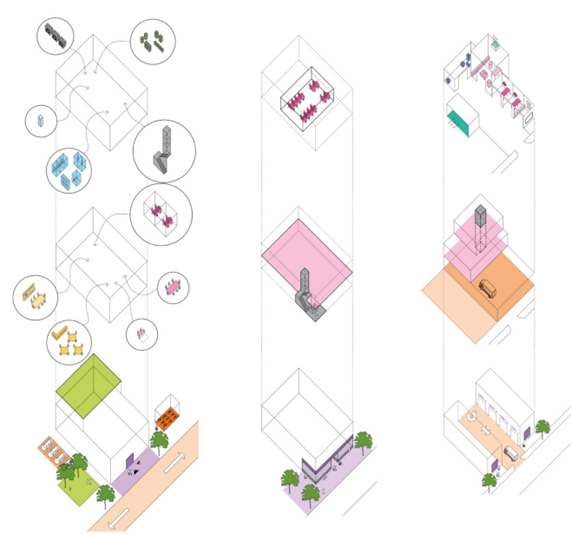
Diagrams of key attributes for general workspace design, desk-based workspace and industrial type workspace. 5th Studio.
Diversity of need
Whilst there are some common features that define well-designed accessible workspaces, there is also a huge diversity of different needs, for different scales of business within the same sector.
Businesses which require relatively small spaces can have their own specialist requirements, for example digital and tech. Start-ups can benefit from auditorium style spaces to pitch ideas, small scale maker-spaces can have specific lighting and ventilation needs, and music studios have particular acoustic requirements. Large scale fabrication and maker spaces often need to install and move large pieces of equipment, adjust their ventilation and have good access for vehicular distribution.
Generic workspace design is unlikely to be able to respond to the rich, varied and changing needs of every businesses within a range of sectors. Beyond the initial design, good workspaces should include engagement with building managers and potential occupants so that specific needs can be accommodated and flexibility to adapt can be integrated into proposals.
Businesses which require relatively small spaces can have their own specialist requirements, for example digital and tech. Start-ups can benefit from auditorium style spaces to pitch ideas, small scale maker-spaces can have specific lighting and ventilation needs, and music studios have particular acoustic requirements. Large scale fabrication and maker spaces often need to install and move large pieces of equipment, adjust their ventilation and have good access for vehicular distribution.
Generic workspace design is unlikely to be able to respond to the rich, varied and changing needs of every businesses within a range of sectors. Beyond the initial design, good workspaces should include engagement with building managers and potential occupants so that specific needs can be accommodated and flexibility to adapt can be integrated into proposals.
Opportunities for ‘accessible’ workspace
The opportunities for workspace provision sit in a number of different contexts, each requiring different consideration in terms of planning and design.
The complexities of incorporating good accessible workspace into new mixed-use, co-location, or industrial intensification developments requires a design-led approach to resolve the often-conflicting needs of different users. Too often on residential-led schemes there is a tendency for employment uses to be designated in the left-over space under housing, squeezed into cellular units, with minimal consideration given to the space needed for connection, collaboration, vehicular access, yard space or vertical circulation, between the static and inflexible demands of bikes, bins, parking, plant, and circulation cores for the residential accommodation. Vertical co-location of workspace needs careful consideration to successfully meet the needs of all users and provide an active and attractive public realm. Increasingly the demands of flexible and accessible workspace are being met through providing space for employment uses adjacent to residential, including stacking industrial type uses.
The refurbishment or repurposing of buildings with other uses into accessible workspace can provide permanent space for businesses, or temporary accommodation as part of meanwhile masterplans in evolving contexts.
The refurbishment or repurposing of buildings with other uses into accessible workspace can provide permanent space for businesses, or temporary accommodation as part of meanwhile masterplans in evolving contexts.
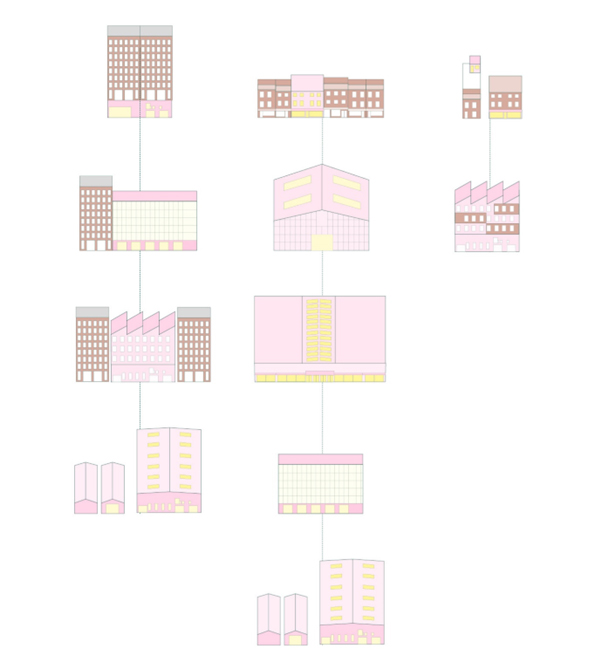
Illustrations of opportunities for affordable workspace, from left: New build, Refurbished and Live/work settings. 5th Studio.
Commercial office buildings already have some of the key components needed for desk-based collaborative employment uses, and may require only minor adjustments to the fit-out and layout to adapt them into successful accessible workspace. The Coalface in Finsbury Park, London, is an example of commercial space above retail being converted into co-working space.
Industrial buildings can be brick-built warehouses or factories, embedded in the city, or sheet-metal sheds on peripheral industrial estates. These can readily be converted into collaborative maker-spaces and studios, that are flexible and adaptable. They can also offer space and infrastructure for outdoor events and activities that can benefit the wider neighbourhood. Bloqs in Meridian Water, London, is an example of a converted industrial building which now provides space for the UK’s first open-access factory.
Retail space comes in many different forms, including; shops on a high-street, indoor shopping malls and big-box retail centres. With the changing nature of retail, linked to internet use and home delivery, the future adaption of the high street and shopping centres needs to be carefully considered to ensure they can be retained as vibrant and lively places. This might include the careful integration of accessible workspace in clusters, based on the workshop-above-shop model.
Industrial buildings can be brick-built warehouses or factories, embedded in the city, or sheet-metal sheds on peripheral industrial estates. These can readily be converted into collaborative maker-spaces and studios, that are flexible and adaptable. They can also offer space and infrastructure for outdoor events and activities that can benefit the wider neighbourhood. Bloqs in Meridian Water, London, is an example of a converted industrial building which now provides space for the UK’s first open-access factory.
Retail space comes in many different forms, including; shops on a high-street, indoor shopping malls and big-box retail centres. With the changing nature of retail, linked to internet use and home delivery, the future adaption of the high street and shopping centres needs to be carefully considered to ensure they can be retained as vibrant and lively places. This might include the careful integration of accessible workspace in clusters, based on the workshop-above-shop model.
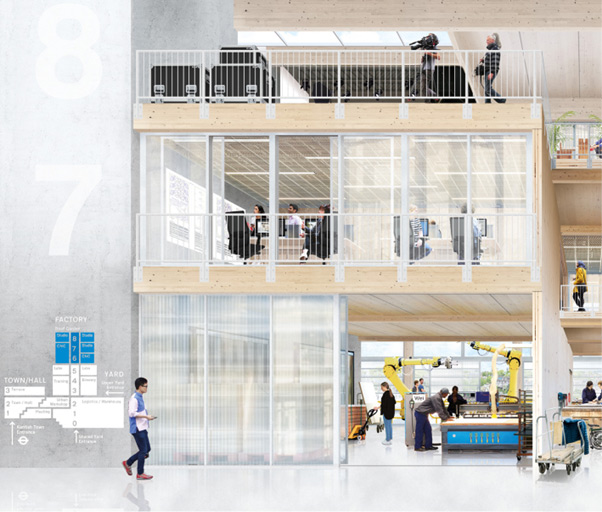
Visualisation of a new-build multi-storey industrial building. 5th Studio.
Planning for accessible workspace
The planning and design of accessible workspace needs a strategic and holistic approach, looking at economics, design, delivery and management - alongside the physical and social context. Working with Avison Young, 5th Studio have been providing advice to local authorities on where and how the diverse needs of accessible workspace can be accommodated, so they can plan successfully for the future.
February Phillips is an Associate at 5th Studio. She is an experienced architect and urban designer and her roles have included being lead consultant, project architect, project manager, principal designer and contract administrator on a wide range of commissions. She has been involved in a number of accessible workspace commissions, including design inputs for the Haringey Workspace Study and Haringey Cultural Quarter Masterplan, and the high-profile Bloqs open-access factory in Meridian Water.
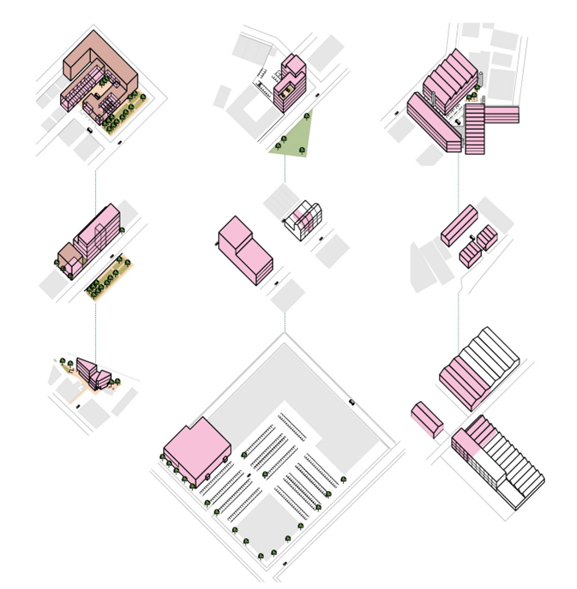
Examples of location-based workspace typologies, from left: New-build, Refurbishment of Office and Retail, and Industrial. 5th Studio.
Patrick Ransom is a Director in our London Planning, Development and Regeneration team. He is an Accessible Workspace commentator and has undertaken research on the topic for the London Boroughs of Brent, Hammersmith & Fulham, Haringey, Lambeth, Islington, Tower Hamlets, Camden and Hackney.
